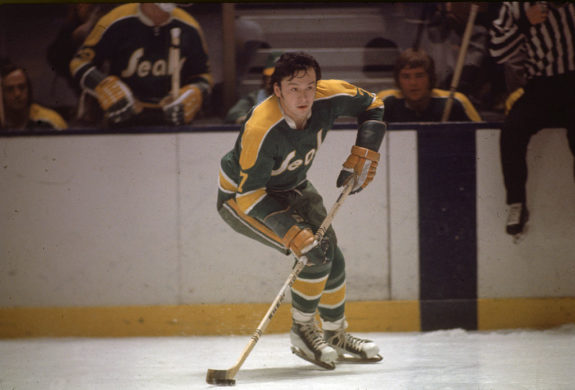The NHL has consisted of mostly Canadians, Europeans, and Americans from colder climates for the past few decades. Although it’s far from being seen as a hockey hotbed, California-born players are starting to make an impact around the league. Some of them grew up in the Golden State while others were simply born there and grew up elsewhere. Regardless of the circumstances, this is an important turning point in a nontraditional market that has struggled to produce talent in the past. There have been a few players that have broken through, however, none of them have ever reached the performance level we’re seeing today. We’ve seen a total of 48 players come out of the state with only four of those playing at least 500 games. There will certainly be a few more passing that mark in the near future, but before we get into the modern age, we should dive into how it came to be.
The History of California Hockey
Hockey in California dates back much further than most realize with leagues forming well before the California Seals and Los Angeles Kings joined the NHL. The Seattle Metropolitans and Montreal Canadiens actually played an exhibition series in the Bay Area in 1917. There were even California Universities such as the University of California Los Angeles (UCLA) and University of Southern California (USC) icing teams as early as 1926. Both of these teams are still in existence today and are part of the NCAA’s PAC-8 Conference. Unfortunately, there isn’t much information available about the hockey scene in those days, but hockey was getting some coverage, as seen in an issue of the Oakland Tribune from Dec. 1929, however, it’s clear to see that it wasn’t given as much attention as other sports (from ‘National Ice Hockey Increase Squad Limit’, Oakland Tribune, Dec. 18, 1929).
Professional hockey was attempted in California a few times over the years with the California Hockey League popping up first in 1928 and the Pacific Coast Hockey League turning professional in 1948. However, it wasn’t until the Western Hockey League brought in the San Francisco Seals that it actually started to take off. They played in the legendary Cow Palace which will be familiar to fans of the NHL, as that was the original home of the San Jose Sharks in the early 1990s. Eventually, the Seals moved a few cities over to Oakland and the rest is history (from ‘The California Golden Seals: A Tale of White Skates, Red Ink, and One of the NHL’s Most Outlandish Teams’, University of Nebraska Press, Currier, S., 2017).

The more well-known side of Californian hockey started with the 1967 expansion of the NHL when the California Seals, who later became the Oakland Seals, Bay Area Seals, and finally California Golden Seals before they moved to Cleveland, as well as the Kings, who have remained in Los Angeles, came into the league.
The first California-born player to reach the NHL was Chris Ahrens who spent almost his entire professional career with the Minnesota North Stars. The San Bernardino-born defenseman also played a few games in the World Hockey Association with the Edmonton Oilers. His career was fairly short, however, it was certainly a major milestone for hockey in the Golden State.
Oakland-born defenseman Lee Norwood was the first Californian to reach the 500-game milestone in the NHL. He went on to have a 12-year career with seven teams before retiring with the Calgary Flames following the 1993-94 season. After Norwood, there weren’t many notable impact players at the NHL level for nearly a decade. During the 2002-03 season, San Francisco native Brooks Orpik made his debut with the Pittsburgh Penguins. He went on to have a 16-year career split between the Penguins and the Washington Capitals and played a total of 1,035 games. For a portion of his career, he was teammates with another Californian, Beau Bennett as well.
The Modern Golden Age of California Hockey
We’re currently experiencing the greatest era of California hockey players to date. Jason Robertson is having a tremendous start to his career, and his brother Nick is trying to find his way in Toronto alongside a Californian-born superstar Auston Matthews. Although Matthews spent most of his childhood in Arizona, he was born in San Ramon. Trevor Moore recently signed a five-year, $21 million extension with his hometown Kings. San Diego native Thatcher Demko struggled during the 2022-23 season, but he has previously cemented himself as the Vancouver Canucks’ starting goaltender and even earned some Vezina Trophy votes last season. There are also quite a few others such as Jason Zucker and Matt Nieto who have been very impactful players in their own right. Cam York is also starting to break into the Philadelphia Flyers lineup regularly as one of their top prospects. There are a few draft-eligible players such as Aidan Park coming through the system as well.

Having this many players coming out of a nontraditional hockey market has done wonders for the game. A large amount of it can be traced back to the infamous Wayne Gretzky trade which undoubtedly increased the following of the sport in the area. The game is continuing to grow rapidly with fans in California finding the game through social media, the ties between the Mighty Ducks film franchise and the Anaheim Ducks, and quite a few other ways. The more that markets like this continue to grow, it will benefit the sport, the players, and the industry as a whole. California may not be a hotbed of hockey; however, there’s a chance that won’t always be the case.
Related: 10 Greatest LA Kings of All Time
Hockey in the Golden State is in a better position than ever and with three NHL teams across the state, it’s more accessible than ever. That doesn’t even factor in the big presence of the American Hockey League and the five teams the state possesses. The fact that there are a total of eight teams from the top two levels of North American hockey in California means that the game is highly accessible wherever you go. Having this group of California-born stars and some exciting prospects joining the Ducks, Kings, and Sharks will only continue to grow the game and make their presence a regular occurrence rather than a rarity.